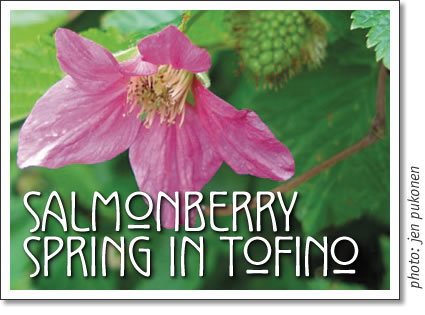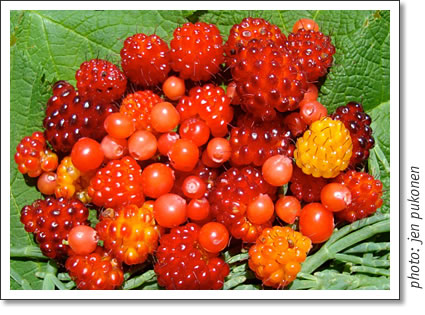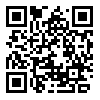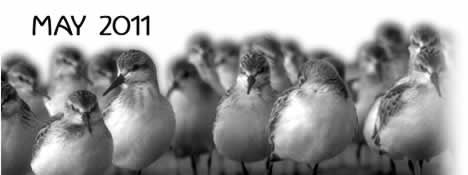
Tofino Salmonberry Spring
by Jen Pukonen, Tofino
 The striking pink flowers of the salmonberry bush are always a welcome sign of spring here on the ‘wet coast’. They signal the return of longer days, sunshine, and delicious berries to come. Even the scientific name – Rubus spectabilis – sounds like a celebration.
The striking pink flowers of the salmonberry bush are always a welcome sign of spring here on the ‘wet coast’. They signal the return of longer days, sunshine, and delicious berries to come. Even the scientific name – Rubus spectabilis – sounds like a celebration.
The timing of salmonberry blossoms and berries are linked to a number of natural phenomena. For example, the return of the Rufous Hummingbird in late March or early April often occurs within a day or two of the first blossoms – and in turn the availability of nectar. Imagine how delicious this sweet treat must be after a long migration from central Mexico!
Throughout the Northwest Coast, the ripening of the berries in late May or June is associated with the song of the Swainson’s Thrush, which is known as the ‘salmonberry bird’ in many First Nation languages on the coast. For the Nuu-chah-nulth First Nations the ripening of salmonberries is used as an indicator of the return of adult sockeye salmon. It was also believed that lots of salmonberries meant that lots of sockeye would be available.
And, in recent years, the timing of salmonberry blossoms has been used as an indicator for a monitoring program to gather information about climate change in our region. Since 2008 the Clayoquot Biosphere Trust (CBT) has been asking local volunteers to identify a salmonberry plant that they can easily check on a daily basis each spring and record the date when they see the first flower. If you are interested in learning more about the monitoring project or would like to get involved, check out the CBT’s website at www.clayoquotbiosphere.org
Salmonberries are a culturally important plant for the Nuu-chah-nulth, and have been used as both food and medicine for millenia. The Nuu-chah-nulth name for the salmonberry bush is “qawiishmapt” (in the Tla-o-qui-aht dialect). Historically, both the shoots and berries were eaten in great quantities. The new shoots, called “m’ayii” were gathered in early spring as a green vegetable. The shoots were peeled and eaten raw, or also sometimes steamed. They have a sweet and juicy flavour and were often eaten with salmon and dried salmon eggs.

The berries, called “qawii,” are one of the first berries to ripen in our region. They look similar to raspberries and come in a range of colours from peachy salmon to ruby red. They were usually eaten fresh because they are too watery to dry into cakes like other berries often were. As with other types of plant foods, salmonberry patches could be owned by families or individuals. Families were responsible for tending the plants and carefully regulating the harvest to ensure that there would always be plenty for generations to come. In addition to providing a valuable food source, salmonberry roots and leaves were also used medicinally. Both the shoots and berries are still widely enjoyed today.
If you don’t already have one growing in your yard, salmonberries make a great addition to any coastal garden. Not only are they beautiful and edible but they are great for “naturescaping,” or attracting wildlife. As I mentioned before, the nectar provides an important food source for hummingbirds. In turn, the hummingbirds pollinate the plants helping them to grow fruit and seeds that feed a variety of other birds later in the year. The flowers also provide an important nectar source for butterflies, bees and various other insects. In time salmonberry bushes form a dense thicket, which becomes an ideal spot for nesting songbirds and small mammals alike. An important riparian species, the salmonberry is also helpful in preventing erosion. With its deep roots and good soil binding qualities, these shrubs can hold soil intact at the edge of a stream, pond, ditch or on a steep slope.
A member of the Rose Family (Rosaceae) and closely related to raspberry, blackberry and loganberry, salmonberry is a fast growing rhizomatous shrub that usually grows between 1-4m tall, with erect or gracefully arching stems. Because they are native to our region, once established, they are low maintenance and don’t require any watering or other inputs.
The berries of this ecologically and culturally important plant also provide a good natural source of vitamin C and might even help to fend off some of those spring sniffles that are going around. So on the next sunny day (salmonberries can be pretty mushy after a heavy rain), find a bountiful bush and try a handful.
If you’re heading out to snack on salmonberries remember that they often form extensive clones, some of which have much tastier berries than others. So if you taste one that doesn’t suit your palate, wander away and try another.
Many people prefer just to eat the berries right off the bush, but if you’re feeling adventurous try concocting a salmonberry lemonade, make a mixed berry jelly, or whip up a salmonberry vinaigrette and sprinkle a handful of berries on a green salad.
Whichever way you choose to eat them, enjoy!
Note: Please use caution when harvesting or eating any parts of a wild plant. Be sure you can identify the plant and know which parts are edible. Some plants have parts that are edible and parts that are toxic, while others are edible at a certain stage of maturity and not at others. Lastly, be respectful, do not over-harvest, leave some fruits for reseeding and for wildlife.
Jen is a Tofino naturalist and ethnobotanist who loves to snack on local berries. She works for the Raincoast Education Society. Visit the RES website at www.raincoasteducation.org. Special thanks to Gisele Martin for sharing her knowledge of the Nuu-chah-nulth language and uses of salmonberry.
Tofino Time May 2011
- Tofino in May 2011
- Tofino event listings for May 2011
- Tofino concerts in May 2011
- Tofino movies in May 2011
- Tofino tide table for May 2011
- Tofino surf reports for May 2011
- The year of Tofino Beer: Tofino Brewing Co.
- Salmonberry Spring in Tofino
- Feast your eyes at the Ucluelet Aquarium
- Tofino yoga classes May 2011
- Tofino Shorebird Festival: May 6-8, 2011
- Feast! Tofino-Ucluelet Culinary Festival
- Open House on Clayoquot Island
- Tofino wellness: Fight off Allergies this Season!
- Tofino gardening in May 2011
- Horoscope for May 2011
- Community Directory: Goods & Services in Tofino
tofino | tofino time | activities | accommodation | events | directory
maps | travel | food | art & artists | photos | horoscope | tides
search | magazine | issues | articles | advertising | contact us
hosted in tofino by tofino.net & studio tofino
© 2002-2014 copyright Tofino Time Magazine in Tofino Canada
 The pink flowers of the salmonberry bush - Rubus spectabilis - are always a welcome sign of spring here in Tofino.
The pink flowers of the salmonberry bush - Rubus spectabilis - are always a welcome sign of spring here in Tofino.

quick links:
- tofino accomodations
- tofino calendar
- tofino surf report
- tofino horoscope
- march horoscope
- tofino map
- tofino fishing report
- tofino tides
- tofino weddings
tofino events:
- tofino concerts
- tofino events
- tofino movies
- tofino festivals
- tofino yoga classes
- tofino whale festival
tofino time magazine:
- tofino time march 2016
- tofino event listings march 2016
- tofino concerts in march 2016
- tofino movies in march 2016
- cox bay | wickaninnish beach
- chesterman beach
- tonquin beach
- tofino brewing co.
- tofino wedding guide
tofino accommodation:
- tofino cabin
- tofino camping
- bed & breakfasts in Tofino
- tofino hostels
- tofino motels
- tofino hotels
- tofino vacation rentals
- petfriendly accommodation
activities:
- tofino bike rentals
- tofino bear watching
- tofino bird watching
- tofino boat charters & cruises
- tofino fishing
- hot springs cove
- sea kayaking in tofino
- tofino storm watching
- tofino surfing
- tofino whale watching
- tofino yoga
shopping:
services:
- tofino yoga, spa & wellness
- tofino restaurants
- tofino internet cafes
- tofino travel & transportation
- tofino real estate
- tofino taxi services
- tofino wedding & events
